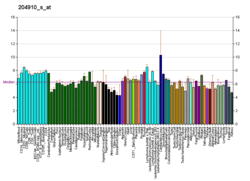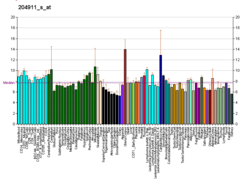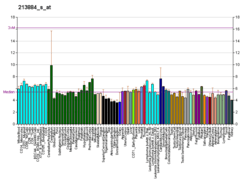TRIM3
Tripartite motif-containing protein 3 is a protein that in humans is encoded by the TRIM3 gene.[5][6]
The protein encoded by this gene is a member of the tripartite motif (TRIM) family, also called the 'RING-B-box-coiled-coil' (RBCC) subgroup of RING finger proteins. The TRIM motif includes three zinc-binding domains, a RING, a B-box type 1 and a B-box type 2, and a coiled-coil region. This protein localizes to cytoplasmic filaments. It is similar to a rat protein which is a specific partner for the tail domain of myosin V, a class of myosins which are involved in the targeted transport of organelles. The rat protein can also interact with alpha-actinin-4. Thus it is suggested that this human protein may play a role in myosin V-mediated cargo transport. Alternatively spliced transcript variants encoding the same isoform have been identified.[6]
Interactions
TRIM3 has been shown to interact with Actinin alpha 4.[7]
References
- 1 2 3 GRCh38: Ensembl release 89: ENSG00000110171 - Ensembl, May 2017
- 1 2 3 GRCm38: Ensembl release 89: ENSMUSG00000036989 - Ensembl, May 2017
- ↑ "Human PubMed Reference:".
- ↑ "Mouse PubMed Reference:".
- ↑ El-Husseini AE, Vincent SR (August 1999). "Cloning and characterization of a novel RING finger protein that interacts with class V myosins". J Biol Chem. 274 (28): 19771–7. doi:10.1074/jbc.274.28.19771. PMID 10391919.
- 1 2 "Entrez Gene: TRIM3 tripartite motif-containing 3".
- ↑ El-Husseini, A E; Kwasnicka D; Yamada T; Hirohashi S; Vincent S R (January 2000). "BERP, a novel ring finger protein, binds to alpha-actinin-4". Biochem. Biophys. Res. Commun. UNITED STATES. 267 (3): 906–11. doi:10.1006/bbrc.1999.2045. ISSN 0006-291X. PMID 10673389.
Further reading
- El-Husseini AE, Kwasnicka D, Yamada T, et al. (2000). "BERP, a novel ring finger protein, binds to alpha-actinin-4". Biochem. Biophys. Res. Commun. 267 (3): 906–11. doi:10.1006/bbrc.1999.2045. PMID 10673389.
- El-Husseini AE, Fretier P, Vincent SR (2001). "Cloning and characterization of a gene (RNF22) encoding a novel brain expressed ring finger protein (BERP) that maps to human chromosome 11p15.5". Genomics. 71 (3): 363–7. doi:10.1006/geno.2000.6452. PMID 11170753.
- Reymond A, Meroni G, Fantozzi A, et al. (2001). "The tripartite motif family identifies cell compartments". EMBO J. 20 (9): 2140–51. doi:10.1093/emboj/20.9.2140. PMC 125245. PMID 11331580.
- Lee SJ, Choi JY, Sung YM, et al. (2001). "E3 ligase activity of RING finger proteins that interact with Hip-2, a human ubiquitin-conjugating enzyme". FEBS Lett. 503 (1): 61–4. doi:10.1016/S0014-5793(01)02689-8. PMID 11513855.
- Strausberg RL, Feingold EA, Grouse LH, et al. (2003). "Generation and initial analysis of more than 15,000 full-length human and mouse cDNA sequences". Proc. Natl. Acad. Sci. U.S.A. 99 (26): 16899–903. Bibcode:2002PNAS...9916899M. doi:10.1073/pnas.242603899. PMC 139241. PMID 12477932.
- Ota T, Suzuki Y, Nishikawa T, et al. (2004). "Complete sequencing and characterization of 21,243 full-length human cDNAs". Nat. Genet. 36 (1): 40–5. doi:10.1038/ng1285. PMID 14702039.
- Yan Q, Sun W, Kujala P, et al. (2005). "CART: an Hrs/actinin-4/BERP/myosin V protein complex required for efficient receptor recycling". Mol. Biol. Cell. 16 (5): 2470–82. doi:10.1091/mbc.E04-11-1014. PMC 1087250. PMID 15772161.
- Olsen JV, Blagoev B, Gnad F, et al. (2006). "Global, in vivo, and site-specific phosphorylation dynamics in signaling networks". Cell. 127 (3): 635–48. doi:10.1016/j.cell.2006.09.026. PMID 17081983.






